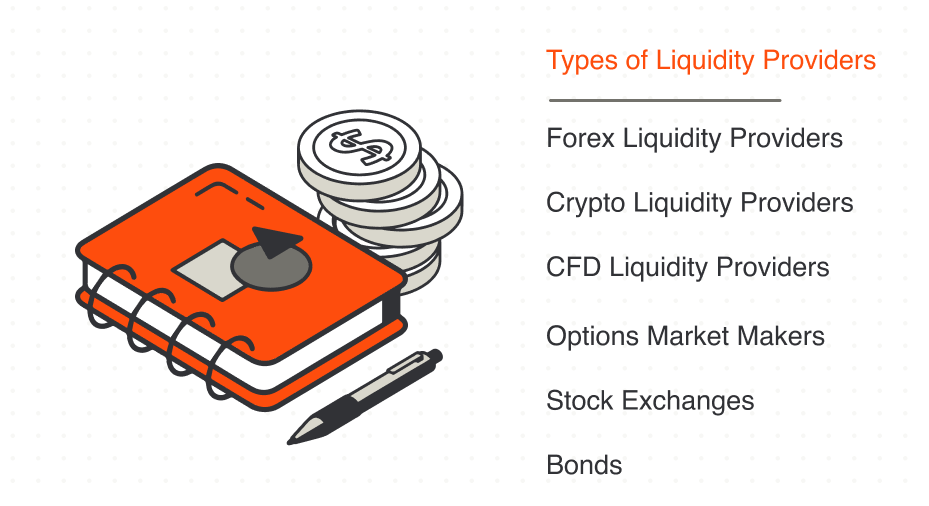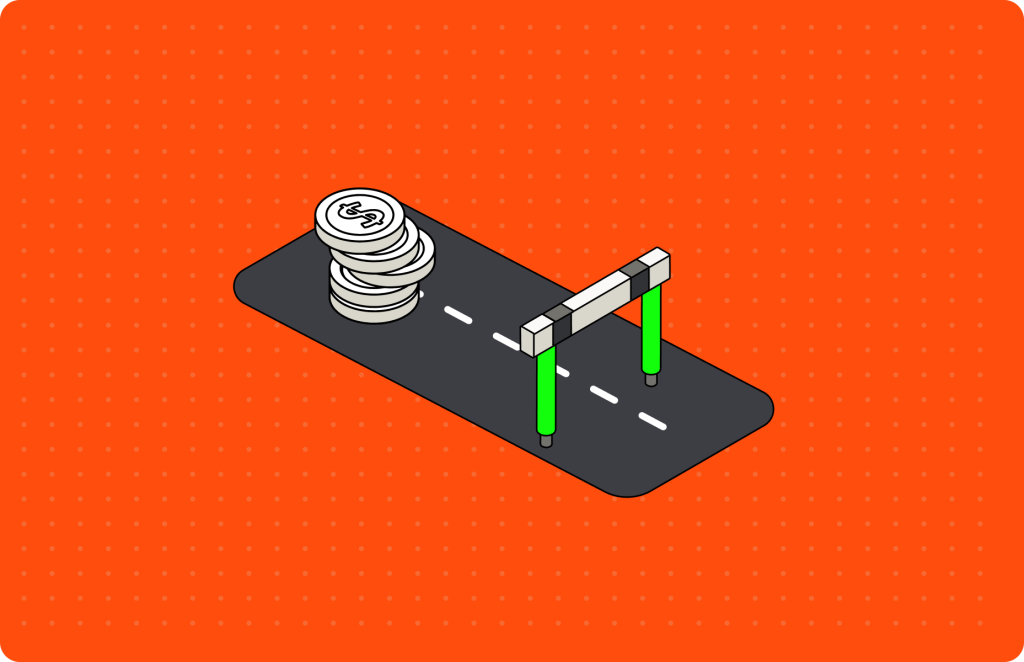Brokerage Business
8 minutes read
Oct 11, 2024
Understanding Liquidity Providers: A Comprehensive Guide
What is a Liquidity Provider?
A liquidity provider, is a financial institution or brokerage that actively trades on various exchanges and trading platforms. Their core function is to enhance liquidity within the markets by ensuring there is always demand for buying and selling of any tradable asset.
As a trader, you will likely interact with liquidity providers without even realising it as they operate behind the scenes. Whenever you place an order to buy or sell a security, currency, commodity, or other financial instrument, a liquidity provider may be fulfilling your order through their activities of continuously offering competitive bids and asking prices.
Simply put, liquidity providers bridge the gap between buyers and sellers by standing ready to trade at any given time. Their goal is to maintain a constant two-way flow of orders that serve to even out supply and demand imbalances, keeping markets fluid and allowing you to easily enter and exit positions at fair prices.
Who is the Biggest Liquidity Provider?
As an active trader or business operator, you understand the importance of reliable liquidity sources that can empower your efforts. Behind the scenes, vast networks of specialized liquidity providers work constantly to maintain two-way flows across global exchanges. Let’s examine some of the foremost players driving this effort.
Commanding a great respect is FXCM Prime, a comprehensive package simplifying Forex access. By assembling trades from an array of liquidity sources into a centralised portfolio view, FXCM Prime grants seamless exposure to over 400 currency pairs. Finalto maintains a similar multi-venue approach spanning 80 currencies and asset classes.
Also, B2Broker is considered one of the biggest liquidity providers of choice. With over a decade of experience serving clients in over 50 countries, B2Broker brings unmatched execution capabilities through partnerships with Tier 1 banks and non-bank providers. They lift the industry standard through innovative products catering to diverse needs across FX, cryptocurrencies, and securities.
Meanwhile, Advanced Markets lifts institutional Forex brokers through prized relationships with banking titans like UBS and Standard Chartered. Their best execution model directly routes each order for optimal pricing. Scope Markets also excels through a client-centric culture and flexible solutions tailored to individual needs.
Beyond traditional currencies, Nexo Prime leads the crypto market by combining deep spot liquidity with OTC derivatives and insurance protections of up to $775 million. Their efforts safeguard assets for over 5 million users globally. No matter your preferred markets, ensuring your operations interface with best-in-class liquidity providers can unlock otherwise untapped opportunities. Let their muscular capabilities amplify your strategies.
Other major liquidity providers in the worldwide Forex ecosystem that you’ve likely interacted with include:
- FXCM Prime – FX LP
- Finalto – Multi Asset LP
- Advanced Markets – LP for Institutional FX Brokers
- Top FX – Retail LP
- Swissquote Bank – ETF LP
- Saxo Bank – Equities LP
- Invast Global – FX Prime of Prime LP
- IXO Prime – FX and Crypto Technology and LP
- Equity Capital – FCA-regulated LP
- CMC Markets Connect – Web-based Platform LP
- Amana – CFD LP
- Scope Markets – LP with Good Customer Service
- FXSpotStream – Liquidity Aggregator
- Nexo Prime – Crypto LP
However, no single entity can maintain liquidity across all markets alone. Liquidity provision involves tapping into extensive networks and alliances with other banks, brokers, trading firms, and platforms. Together they pool liquidity resources to serve the ever-growing connectivity needs of global finance.
How Do Liquidity Providers Make Money?
By now you understand the pivotal role liquidity providers play in maintaining efficient markets. But how exactly do they fund these critical operations and generate a profit themselves? At the core, providers employ sophisticated techniques across multiple revenue streams.
- Bid-Offer Spreads: By constantly posting buy and sell quotations, providers earn fractional profits as currencies or assets are exchanged between those prices. While individually slim, capturing these spreads at the scale of millions of daily trades adds up tremendously.
- Optimizing Order Flow: Through exclusive order routing arrangements, providers maximize internal matching of flow before outward transmission. This allows internally pocketing advantageous prices on larger volumes.
- Exchange Rebates: Many trading platforms incentivize tight spreads and volume through rebate programs refunding a portion of trading fees. Providers structure operations to maximize these valuable cash returns.
- Investment Income: Idle capital is carefully invested in low-risk assets like treasuries and money markets, generating steady returns without taking on prohibitive risk.
- Commission Sharing: Preferred broker and platform relationships see providers receiving a cut of any transaction costs charged to clients. Strategic partnerships optimize these lucrative revenue streams.
- Technology licensing: Leading providers successfully monetize sophisticated pricing, routing, and execution platforms through licensing usage by brokerage and exchange clients.
You’ll also find innovative organizations exploring creative income avenues like deposit interest schemes, prime brokerage services, and quantitative trading strategies. Overall, providers harness multi-pronged profit drivers to permanently supply the liquid oxygen powering worldwide finance.
How Do Liquidity Providers Work?
1. The Tiered Liquidity Infrastructure
At the highest levels of the infrastructure lies Tier 1 players such as Barclays, Morgan Stanley, and Goldman Sachs. As some of the largest international banks in the world, they facilitate the trading of enormous volumes directly among each other daily. This tier forms the primary pool of liquidity that powers the entire global market.
Below the Tier 1 banks are the Tier 2 entities like medium-sized banks, brokers, electronic platforms, and other institutions. While smaller in size and scope than the Tier 1 players, these outfits perform the critical role of plugging into the Tier 1 reservoirs to source live pricing data. They then transmit these prices onward to other participants in the financial system.
Together, this stratified tiered structure forms the backbone of continuous liquidity provision globally. It efficiently cascades flows from the largest Wall Street players down to smaller retail brokers and traders. In this way, even the smallest market participants can seamlessly access pricing signals and trade opportunities around the world.
2. Advanced Technology
Powering the intricate plumbing of modern markets are advanced technological systems. Cutting-edge electronic trading platforms and the FIX communications protocol underpin the ultrafast execution capabilities required in today’s markets. These platforms aggressively poll the different tiers around the clock for the best tradable prices.
When an order is placed, matching engines harnessing sophisticated algorithms can internally or externally complete the trade instantly through high-speed infrastructure. Liquidity aggregators further optimize outcomes by sourcing the best options available from an array of liquidity providers.
Underlying it all is a commitment to ongoing innovation. Providers continuously refine systems to future-proof operations and ensure the capability to address nascent frontiers like cryptocurrencies utilizing groundbreaking tech like distributed ledger technologies.
3. Facilitating Order Flow
Small retail flow is readily absorbed into deep pools of internal liquidity maintained by providers. Here, high trading volumes allow direct matching between client orders. However, larger institutional-sized flow may require onward routing if exceeding internal capacity. Strategic relationships with Tier 1 banks and trading venues form the secondary outlets that seamlessly continue fulfilling large orders. Slick algorithms deployed intelligently guide fluid transitioning between internal and external sources.
Throughout, providers strategically leverage world-class connectivity to maintain participants’ uninterrupted access to opportunities wherever markets trade internationally. Their role as the vital behind-the-scenes conveyors of order flow remains mission-critical.
4. Uninterrupted Liquidity
To consistently supply liquidity despite ever-shifting conditions, providers deploy an array of techniques. Dynamic hedging and portfolio rebalancing counter volatility risks by offsetting exposures in real-time. Quantitative models powered by reams of market data factor in myriad supply-demand variables. They accurately generate competitive pricing signals and provide the analysis layer monitoring overall infrastructure health.
Together, these components fortify an ongoing circulation of buyers and sellers across all asset classes. Participants benefit through their ensured ability to cost-effectively enter and exit positions seamlessly on a 24/7 global basis.
Types of Liquidity Providers

While the core function is similar, liquidity providers operate across numerous specialized markets:
1. Forex Liquidity Providers
As mentioned, major banks are primary Forex liquidity providers due to the market’s sheer size. Lower barriers to entry also open the field to brokerages and smaller currency firms.
2. Crypto Liquidity Providers
In decentralized cryptocurrency exchanges, providers deposit funds into market maker “liquidity pools” to facilitate trades and earn fees. Sophisticated algorithms then deftly recalibrate pricing proportional to deposited liquidity tokens, powering crypto trading.
3. CFD Liquidity Providers
CFDs empower exposure to underlying prices without holding physical assets. Providers ably amalgamate CFD liquidity into offerings while systematically offsetting non-directional exposure fluctuations through hedging.
4. Options Market Makers
Liquidity in options chains requires balancing the complex risks of derivatives. SDedicated trading firms deploy market acumen and ample balance sheets to consistently balance inherent risks across option chains.
5. Stock Exchanges
Designated market makers commit to posting buy/sell quotes near the best bid/ask on an assigned basket of stocks. In return, they earn benefits like lucrative insider access to order flow data.
6. Bonds
Bond liquidity providers maintain electronic bond platforms and work closely with brokers and dealer networks for institutional fixed-income needs.
Regardless of specialized focus, all maximize traders’ seamless entry/exit across coveted markets through dependably synchronized liquidity circulations. Their sector-tailored operations remain foundationally important to interwoven global markets.
Final Thoughts
In modern interconnected markets, liquidity providers play an indispensable role as the connective tissues keep trading systems fluid. While operating behind the scenes, their constant contributions to liquidity depth, tight pricing, and fast order matching are fundamental to an equitable and cost-effective trading experience.
With technology now powering the instantaneous velocity of global finance, liquidity providers play an increasingly important part in maintaining orderly flows. Through understanding their workings, you can maximize the unseen benefits they offer and feel confident taking advantage of new opportunities across diverse investment horizons.
FAQ
203
Read more

Brokerage Business
10 minutes read
Sep 30, 2025
The brokerage industry in 2026 is entering a new phase shaped by technology, regulation and shifting client demands.



